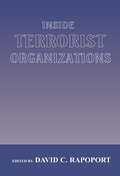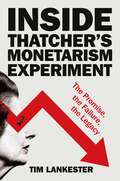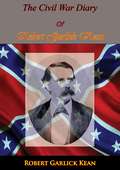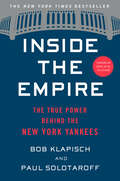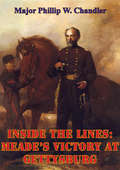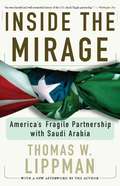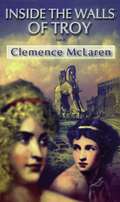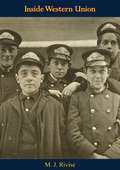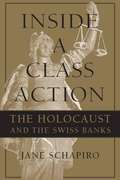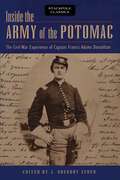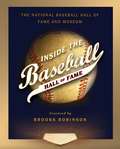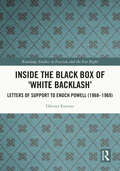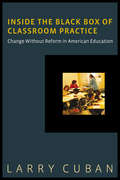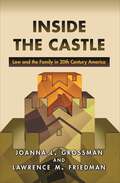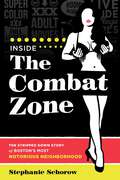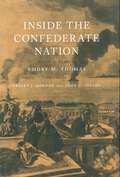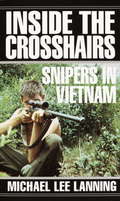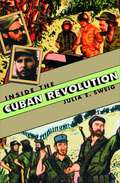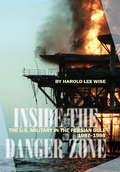- Table View
- List View
Inside Terrorism (Columbia Studies in Terrorism and Irregular Warfare)
by Bruce HoffmanBruce Hoffman's Inside Terrorism has remained the seminal work for understanding the historical evolution of terrorism and the terrorist mind-set. In this revised third edition of his classic text, Hoffman analyzes the latest developments in global terrorism, offering insight into new adversaries, motivations, strategies, and tactics. He focuses on the rise of ISIS and the resilience of al-Qaeda; terrorist exploitation of the Internet and embrace of social media; radicalization of foreign fighters; and potential future trends, including the repercussions of a post-caliphate ISIS.Hoffman examines the demographics of contemporary terrorist leaders and recruits; the continued use of suicide bombers; and the likelihood of a chemical, biological, radiological, or nuclear terrorist strike. He also considers the resurgence of violent antigovernment militants, including white supremacists and opponents of abortion. He argues that the war on terrorism did not end with Osama bin Laden's death and that ongoing instability and strife in Syria, Iraq, Afghanistan, Libya, and Yemen, among other places, will both sustain terrorist movements and have broad implications for domestic and international security around the globe.
Inside Terrorist Organizations
by David C. RapoportThese original essays describe the internal life of terrorist organizations in fascinating detail. They show how no description of terrorist behaviour is adequate without a grasp of the deep tensions that often characterize such groups, and an appreciation of how firmly implanted in our culture terrorist traditions have become, since the middle of the nineteenth century.
Inside Thatcher’s Monetarism Experiment: The Promise, the Failure, the Legacy
by Tim LankesterIn 1979, Margaret Thatcher’s new government was faced with rampant double-digit inflation, rising unemployment and flatlining economic growth. In response, Mrs Thatcher pursued an economic policy which rejected the old orthodoxies and was promoted by only a minority of economists: a policy based on the doctrine of monetarism. This deeply damaging experiment in economic policy making promised much but completely failed to deliver. Tim Lankester was the private secretary for economic affairs to Mrs Thatcher during the early years of her government. His insider’s account explains her attitudes and decisions and those of the other main players. Offering fascinating insights into one of the most unsuccessful episodes of British economic history, he also relates its long-lasting impact and influence on society and the economy to this day, including present-day responses to tackling inflation.
Inside The Confederate Government: The Diary Of Robert Garlick Hill Kean, Head Of The Bureau Of War
by Dr Edward E. Younger Robert Garlick Hill KeanWhen the Civil War began, author Robert Garlick Hill Kean enlisted as a private. In 1862, his wife's uncle, George Wythe Randolph, took Kean on as his aide, and Kean followed him into the War Department at Richmond, where he became the head of the Confederate Bureau of War under John Archibald Campbell, the former U.S. Supreme Court justice. Kean's wartime diary, first published in 1957 and selected as Book-of-the-Month by the Civil War Book Club in May that same year, gives a vivid portrayal of every significant character, of both the military and civilian sectors, who comprised the highest levels of the Confederate government, and to this day is considered an indispensable resource for those seeking first-hand, in-depth discussion and analysis of the Richmond government.
Inside The Empire: The True Power Behind the New York Yankees
by Paul Solotaroff Bob KlapischNew York Times Bestseller: “Pops open the hood of how the Yankees are run and gives us a rare peek at the machinery.” —Tom Verducci, New York Times–bestselling author of The Cubs WayThis is a unique behind-closed-doors look at the New York Yankees, the wealthiest and most famous sports franchise in the world. Using the 2018 baseball season as the backdrop, Inside the Empire gives readers the unvarnished “straight-from-the-gut” truth from Brian Cashman, Aaron Boone, Giancarlo Stanton, C.C. Sabathia—even Hal Steinbrenner and Randy Levine—and many more. It takes you deep into the Yankees clubhouse, their dugout, and the front office, and pulls back the curtain so that every fan can see what really goes on.Bottom line? You may think you know everything about the storied franchise of the New York Yankees and what makes them tick. But Inside the Empire will set the record straight, and drop bombshells about iconic figures along the way. There’s never been a baseball book quite like it.“Excellent behind-the-scenes reporting from cover to cover.” —Mike Vaccaro, New York Post
Inside The Lines: Meade's Victory At Gettysburg
by Major Phillip W. Chandler USMCThe concepts of interior and exterior lines gained prominence during the Napoleonic Era with the writings of Jomini. Interior Lines of Operation deal with forces whose operations diverge from a central point. The use of interior lines allows a commander to rapidly shift forces to the decisive point.The Battle of Gettysburg was a great historical example illustrating the impact of interior and exterior lines. At the Battle of Gettysburg, the Confederates uncharacteristically fought along exterior lines. Their lines of communication stretched from Pennsylvania through the Shenandoah Valley south to Richmond. This was an extremely precarious situation for General Lee and weighed heavily on his decisions at Gettysburg.The Army of the Potomac, under command of newly appointed General Meade, found themselves operating from interior lines at Gettysburg. On July 2 and 3, this became a major factor in General Meade's ability to react to the offensive actions taken by the Army of Northern Virginia.I propose that Lines of Operations, as espoused by Jomini years earlier, was the decisive factor in the Gettysburg Campaign. I believe that the use of interior lines by General Meade, specifically throughout the day and night of Day 2 and again on day 3, allowed the Army of the Potomac to gain victory. The Army of Northern Virginia on several occasions achieved momentary breaks in the Union lines only to be repulsed by Union forces shifted from other positions. General Meade would not have been able to rapidly shift these forces to the decisive point unless he was operating on interior lines.Throughout the three days of battle, General Meade applied Operational Art in positioning his forces at the decisive time and place. One must keep in mind the significance of General Meade's actions at Gettysburg. He defeated the venerable General Robert E. Lee on the battlefield, a feat elusive to all previous commanders of the Army of the Potomac.
Inside The Mirage: America's Fragile Partnership With Saudi Arabia
by Thomas W. LippmanThe relationship between the United States and Saudi Arabia has always been a marriage of convenience, not affection. In a bargain cemented by President Roosevelt and Saudi Arabia's founding king in 1945, Americans gained access to Saudi oil, and the Saudis responded with purchases of American planes, weapons, construction projects and know-how that brought them modernization, education, and security. The marriage has suited both sides. But how long can it last?In Inside the Mirage, journalist and Middle East expert Thomas W. Lippman shows that behind the cheerful picture of friendship and alliance, there is a darker tale. With so much at stake, this compelling account looks at the relationship between these two countries, and their future with one another.
Inside The Third Reich
by Albert SpeerThe classic eye-witness account of Nazi Germany, by Hitler's Armaments Minister and right-hand man.'Inside the Third Reich is not only the most significant personal German account to come out of the war but the most revealing document on the Hitler phenomenon yet written. It takes the reader inside Nazi Germany on four different levels: Hitler's inner circle, National Socialism as a whole, the area of wartime production and the inner struggle of Albert Speer. The author does not try to make excuses, even by implication, and is unrelenting toward himself and his associates ... Speer's full-length portrait of Hitler has unnerving reality. The Führer emerges as neither an incompetent nor a carpet-gnawing madman but as an evil genius of warped conceits endowed with an ineffable personal magic' New York Times
Inside The Third Reich
by Albert SpeerThe classic eye-witness account of Nazi Germany, by Hitler's Armaments Minister and right-hand man.'Inside the Third Reich is not only the most significant personal German account to come out of the war but the most revealing document on the Hitler phenomenon yet written. It takes the reader inside Nazi Germany on four different levels: Hitler's inner circle, National Socialism as a whole, the area of wartime production and the inner struggle of Albert Speer. The author does not try to make excuses, even by implication, and is unrelenting toward himself and his associates ... Speer's full-length portrait of Hitler has unnerving reality. The Führer emerges as neither an incompetent nor a carpet-gnawing madman but as an evil genius of warped conceits endowed with an ineffable personal magic' New York Times
Inside The Walls Of Troy
by Clemence MclarenTwo women, one war. Helen, at age twelve, is not prepared to deal with her famous beauty: to have the face that will launch a thousand ships, kill fifty thousand men, and cause the fall of the world's greatest city. But when she is kidnapped by Theseus of Athens, she begins her journey into womanhood and finds passion strong enough to start the Trojan War. Cassandra has the gift, or curse, to predict the future. When she forsees the ruin of her family and city that Helen's arrival in Troy will cause, she is outraged. Yet she cannot help being drawn to Helen. As the war rages around them, Helen, the woman who started the conflict, and Cassandra, the one who foresaw it, develop a deep friendship. And through their eyes we see the Trojan War in a fascinating new way.
Inside Western Union
by M. J. RiviseRecalling the days before the advent of the internet and social media, when rapid written communication came not electronically, but electromechanically, Inside Western Union is a nostalgic collection of anecdotes by Mike Rivise, an experienced sales manager.In this fascinating book, first published in 1950, the author draws on his own experiences to with many tales of demanding customers who expected the most from their messenger boys, recalls stories of coded messages used to minimize word counts, and provides accounts of crooks that tried to wire the loot across town for later pick up.Rivise also includes details of the history of the Western Union company, including its early takeover by financier Jay Gould in 1881, its acquisition by American Telephone and Telegraph in 1909 following Gould’s death, the arrival of the competing service Postal Telegraph, and the invention of the telegraph by Samuel F. B. Morse, which revolutionised communication.An invaluable read!
Inside a Class Action
by Jane SchapiroOn October 21, 1996, attorney Michael Hausfeld, with a team of lawyers, filed a class-action complaint against Union Bank of Switzerland, Swiss Bank Corporation, and Credit Suisse on behalf of Holocaust victims. The suit accused the banks of, among other things, acting as the chief financiers for Nazi Germany. Hausfeld wanted to use the suit to prove that the banks not only concealed and refused to return millions of dollars in dormant accounts, but that they acted as a conduit for looted assets and slave labor profits. Such behavior, he charged, violated the code of ethics known as customary international law. On August 12, 1998, the plaintiffs and banks reached a $1. 25 billion settlement. Through interviews with a wide range of people involved in the case and detailed research of documents and court transcripts, Jane Schapiro shows the ways that egos, personalities, and values clash in such a complex and emotionally charged case. Inside a Class Action provides an insider s view of a major lawsuit from its inception to its conclusion, which will appeal to anyone interested in human rights, reparations, and international law.
Inside a Gestapo Prison: The Letters of Krystyna Wituska, 1942-1944
by Irene TomaszewskiOn the eve of World War II, Krystyna Wituska, a carefree teenager attending finishing school in Switzerland, returned to Poland. During the occupation, when she was twenty years old, she drifted into the Polish Underground. By her own admission, she was attracted first by the adventure, but her youthful bravado soon turned into a mental and spiritual mastery over fear. Because Krystyna spoke fluent German, she was assigned to collect information on German troop movements at Warsaw's airport. In 1942, at age twenty-one, she was arrested by the Gestapo and transferred to prison in Berlin, where she was executed two years later. Eighty of the letters that Krystyna wrote in the last eighteen months of her life are translated and collected in this volume. The letters, together with an introduction providing historical background to Krystyna's arrest, constitute a little-known and authentic record of the treatment of ethnic Poles under German occupation, the experience of Polish prisoners in German custody, and a glimpse into the prisons of Berlin. Krystyna's letters also reflect her own courage, idealism, faith, and sense of humor. As a classroom text, this book relates nicely to contemporary discussions of racism, nationalism, patriotism, human rights, and stereotypes.
Inside a Madrasa: Knowledge, Power and Islamic Identity in India
by Arshad AlamWhile there exists scholarly works on madrasas in India during medieval times and the colonial period, there is hardly anything on the conditions of madrasas today, and those are by and large based on secondary literature and not grounded in detailed empirical investigation. This work, through ethnographic study undertaken at two madrasas in Mubarakpur in Uttar Pradesh, shows how Indian madrasas represent a diverse array of ideological orientations which is mostly opposed to each other’s interpretation of Islam. If madrasas are about the dissemination of Islamic knowledge, then they also problematize and compete over how best to approach that knowledge; in the process they create and sustain a wide variety of possible interpretations of Islam. This volume will be of interest to scholars and researchers interested in the study of Islam and Indian Muslims. Since it is multidisciplinary in approach, it will find space within the disciplines of sociology, social anthropolgy, history and contemporary studies.
Inside the Apple: A Streetwise History of New York City
by Michelle Nevius James NeviusHow much do you actually know about New York City? Did you know they tried to anchor Zeppelins at the top of the Empire State Building? Or that the high-rent district of Park Avenue was once so dangerous it was called "Death Avenue"? Lively and comprehensive, Inside the Apple brings to life New York's fascinating past.This narrative history of New York City is the first to offer practical walking tour know-how. Fast-paced but thorough, its bite-size chapters each focus on an event, person, or place of historical significance. Rich in anecdotes and illustrations, it whisks readers from colonial New Amsterdam through Manhattan's past, right up to post-9/11 New York.
Inside the Army of the Potomac (Stackpole Classics)
by J. Gregory AckenAt the outbreak of war, twenty-year-old Francis Adams Donaldson enlisted in the 1st California Regiment (later known as the 71st Pennsylvania Volunteers) of the famous Philadelphia Brigade of the II Corps, Army of the Potomac. He fought at Ball&’s Bluff (where he was captured) and participated in the Peninsula Campaign until he was wounded at the Battle of Fair Oaks.Upon his recovery, Donaldson reluctantly accepted promotion to a captaincy I the Corn Exchange Regiment (also known as the 118th Pennsylvania Volunteers), which served throughout its existence in the V Corps. In his new position, Donaldson participated in all the major campaigns and battles in the East through late 1863, including Antietam, Fredericksburg, Chancellorsville, Gettysburg, Bristoe Station, and Mine Run.Although Donaldson made no secret of his distaste for writing he consistently sent home some of his letters filled as many as fifty pages of writing paper. Nearly all of his letter were written in camp of while on active campaign, imparting a freshness and immediacy that is rarely seen. His comments on fellow soldiers—be they lowly privates of major generals—were pointed and unvarnished. In addition to writing ably and including his combat experience, Donaldson also revealed much about the seldom-mentioned factors of army life—the internal feuding, the backbiting, and the politicking that coursed through many Civil War regiments.For more than 125 years, Donaldson&’s letters have lain virtually untouched in the Civil War Library and Museum of Philadelphia. J. Gregory Acken has painstakingly edited these remarkable collection, making these never-before-published letters available for the first time. Their detail and honesty will astonish and enthrall anyone who has ever taken an interest in the Civil War.
Inside the Baseball Hall of Fame
by Brooks Robinson National Baseball Hall of Fame and MuseumFor any baseball fan, a trip to the National Baseball Hall of Fame and Museum in Cooperstown, New York, is the thrill of a lifetime--no matter how many times you visit. But whether you go only once in your lifetime or make the pilgrimage annually, you'll never be able to see every treasure in the museum's collections. With Inside the Baseball Hall of Fame, readers can go behind the scenes to see seldom- or never-displayed items from among the 40,000 treasures in Cooperstown, in addition to some of the most important and popular items on exhibit at the museum--all gorgeously photographed in color. Captions written by Hall of Fame experts explain each object's significance and relate unique stories associated with it. Here are just a few highlights from the nearly 200 objects in this beautiful book: * An 1887 ball-strike indicator from the only season when it took five balls to walk and four strikes to strike out * Pitcher Harvey Haddix's glove from the 1959 game when he pitched 12 perfect innings--and lost 1-0 in the 13th * Shoeless Joe Jackson's shoes * The Wonderboy bat and trombone case that Robert Redford used in The Natural * Rube Waddell's glove from his 4-2, 20-inning victory over Cy Young on July 4, 1905 * A promissory note from the sale of Babe Ruth by Boston Red Sox owner Harry Frazee to New York Yankees owner Jacob Ruppert * The bat Joe Carter used to hit his 1993 World Series-ending home run * The oldest known photograph of two baseball teams, the New York Knickerbockers and the Brooklyn Excelsiors, taken on a ball field in 1859 Whether you're a dedicated student of the game's history or a newcomer to our National Pastime, Inside the Baseball Hall of Fame will fascinate you. You'll find a surprising photograph or a story you didn't know, complete with new insight into America's game and culture. Take the trip of a lifetime inside baseball's national museum and discover the game's fabulous history--or reawaken beloved memories.
Inside the Black Box of 'White Backlash': Letters of Support to Enoch Powell (1968-1969) (Routledge Studies in Fascism and the Far Right)
by Olivier EstevesInside the Black Box of ‘White Backlash’ researches the contents of the letters of support sent to British politician Enoch Powell in the wake of his so-called ‘Rivers of Blood’ speech of April 20, 1968. Never has a politician received so much written support in so short a time. This book takes a thematic approach to investigate the way British whites used Powell’s speech to vent their frustrations, anger, hostility against (non-white) immigrants and the evolution of British society in the late 1960s. Each chapter unpacks one facet of a 10,000-letter sample, out of the approximately 100,000 letters Powell received: Race, State, War, Empire, America, Class, Gender, Elites, Parties, ‘Against’ - with this last chapter analysing letters of protest against Powell. This extraordinary archival material provides an altogether unique window into British society in the late 1960s and reads like a (white) anthropology of nativist Britons in times of swift change. The book will be of interest to both students and academics of race, immigration and ethnicity, as well as by the general public.
Inside the Black Box of Classroom Practice: Change Without Reform in American Education
by Larry Cuban2015 Outstanding Book Award, Association for Educational Communications & Technology (AECT) A book that explores the problematic connection between education policy and practice while pointing in the direction of a more fruitful relationship, Inside the Black Box of Classroom Practice is a provocative culminating statement from one of America&’s most insightful education scholars and leaders.Inside the Black Box of Classroom Practice takes as its starting point a strikingly blunt question: &“With so many major structural changes in U.S. public schools over the past century, why have classroom practices been largely stable, with a modest blending of new and old teaching practices, leaving contemporary classroom lessons familiar to earlier generations of school-goers?&” It is a question that ought to be of paramount interest to all who are interested in school reform in the United States. It is also a question that comes naturally to Larry Cuban, whose much-admired books have focused on various aspects of school reform—their promises, wrong turns, partial successes, and troubling failures. In this book, he returns to this territory, but trains his focus on the still baffling fact that policy reforms—no matter how ambitious or determined—have generally had little effect on classroom conduct and practice. Cuban explores this problem from a variety of angles. Several chapters look at how teachers, in responding to major policy initiatives, persistently adopt changes and alter particular routine practices while leaving dominant ways of teaching largely undisturbed. Other chapters contrast recent changes in clinical medical practice with those in classroom teaching, comparing the practical effects of varying medical and education policies. The book&’s concluding chapter distills important insights from these various explorations, taking us inside the &“black box&” of the book&’s title: those workings that have repeatedly transformed dramatic policy initiatives into familiar—and largely unchanged—classroom practices.
Inside the Castle: Law and the Family in 20th Century America
by Lawrence M. Friedman Joanna L. GrossmanA comprehensive social history of families and family law in twentieth-century AmericaInside the Castle is a comprehensive social history of twentieth-century family law in the United States. Joanna Grossman and Lawrence Friedman show how vast, oceanic changes in society have reshaped and reconstituted the American family. Women and children have gained rights and powers, and novel forms of family life have emerged. The family has more or less dissolved into a collection of independent individuals with their own wants, desires, and goals. Modern family law, as always, reflects the brute social and cultural facts of family life.The story of family law in the twentieth century is complex. This was the century that said goodbye to common-law marriage and breach-of-promise lawsuits. This was the century, too, of the sexual revolution and women's liberation, of gay rights and cohabitation. Marriage lost its powerful monopoly over legitimate sexual behavior. Couples who lived together without marriage now had certain rights. Gay marriage became legal in a handful of jurisdictions. By the end of the century, no state still prohibited same-sex behavior. Children in many states could legally have two mothers or two fathers. No-fault divorce became cheap and easy. And illegitimacy lost most of its social and legal stigma. These changes were not smooth or linear—all met with resistance and provoked a certain amount of backlash. Families took many forms, some of them new and different, and though buffeted by the winds of change, the family persisted as a central institution in society. Inside the Castle tells the story of that institution, exploring the ways in which law tried to penetrate and control this most mysterious realm of personal life.
Inside the Combat Zone: The Stripped Down Story of Boston's Most Notorious Neighborhood
by Stephanie SchorowBoston has always been known for its stiff character. So how did this great New England city become home to one of the largest and most notorious adult entertainment districts in the nation? In this expertly crafted history, veteran reporter Stephanie Schorow teases out the issues that created this controversial neighborhood, giving voice to the players who sought to tame or profit from the sleaze snaking its way through Boston. At turns comic and tragic, Schorow introduces us to the politicians, exotic dancers, and wise guys, and residents brought together by the adult entertainment district—a five-acre neighborhood the city engineered to contain the very porno plague it wanted to eliminate. (Meet the nun-turned-attorney who advocated for the First Amendment rights of adult bookstores, a dancer called &“the thinking man&’s stripper,&” and Boston&’s unofficial city censor.) For these people and thousands of others, the Combat Zone is more than a memory—it was a life-altering adventure.
Inside the Confederate Nation: Essays in Honor of Emory M. Thomas (Conflicting Worlds: New Dimensions of the American Civil War)
by James M. Mcpherson William C. Davis Lesley J. Gordon John C. Inscoe Christopher Phillips William S. Mcfeely Joseph T. Glatthaar Glenna R. Schroeder-Lein Jennifer Gross Clarence L. Mohr Brian Steel Wills Nina Silber Jennifer Lund Smith Frank J. Byrne Thomas G. Dyer Keith Bohannon Jean E. Friedman Rod Andrew Jr. Philip Davis Dillard David McgeeIn The Confederacy as a Revolutionary Experience (1970) and The Confederate Nation (1979), Emory Thomas redefined the field of Civil War history and reconceptualized the Confederacy as a unique entity fighting a war for survival. Inside the Confederate Nation honors his enormous contributions to the field with fresh interpretations of all aspects of Confederate life -- nationalism and identity, family and gender, battlefront and home front, race, and postwar legacies and memories. Many of the volume's twenty essays focus on individuals, households, communities, and particular regions of the South, highlighting the sheer variety of circumstances southerners faced over the course of the war. Other chapters explore the public and private dilemmas faced by diplomats, policy makers, journalists, and soldiers within the new nation. All of the essays attempt to explain the place of southerners within the Confederacy, how they came to see themselves and others differently because of secession, and the disparities between their expectations and reality.
Inside the Crosshairs
by Col. Michael Lee Lanning"The American sniper could be regarded as the greatest all-around rifleman the world has ever known. . . ."At the start of the war in Vietnam, the United States had no snipers; by the end of the war, Marine and army precision marksmen had killed more than 10,000 NVA and VC soldiers--the equivalent of an entire division--at the cost of under 20,000 bullets, proving that long-range shooters still had a place in the battlefield. Now noted military historian Michael Lee Lanning shows how U.S. snipers in Vietnam--combining modern technology in weapons, ammunition, and telescopes--used the experience and traditions of centuries of expert shooters to perfect their craft. To provide insight into the use of American snipers in Vietnam, Lanning interviewed men with combat trigger time, as well as their instructors, the founders of the Marine and U.S. Army sniper programs, and the generals to whom they reported. Backed by hard information and firsthand accounts, the author demonstrates how the skills these one-shot killers honed in the jungles of Vietnam provided an indelible legacy that helped save American lives in Grenada, the Gulf War, and Somalia and continues to this day with American troops in Bosnia.
Inside the Cuban Revolution: Fidel Castro and the Urban Underground
by Julia E. SweigJulia Sweig shatters the mythology surrounding the Cuban Revolution in a compelling revisionist history that reconsiders the revolutionary roles of Fidel Castro and Che Guevara and restores to a central position the leadership of the Cuban urban underground, the Llano. <p><p>Granted unprecedented access to the classified records of Castro's 26th of July Movement's underground operatives--the only scholar inside or outside of Cuba allowed access to the complete collection in the Cuban Council of State's Office of Historic Affairs--she details the ideological, political, and strategic debates between Castro's mountain-based guerrilla movement and the urban revolutionaries in Havana, Santiago, and other cities. <p><p> In a close study of the fifteen months from November 1956 to July 1958, when the urban underground leadership was dominant, Sweig examines the debate between the two groups over whether to wage guerrilla warfare in the countryside or armed insurrection in the cities, and is the first to document the extent of Castro's cooperation with the Llano. She unveils the essential role of the urban underground, led by such figures as Frank País, Armando Hart, Haydée Santamaria, Enrique Oltuski, and Faustino Pérez, in controlling critical decisions on tactics, strategy, allocation of resources, and relations with opposition forces, political parties, Cuban exiles, even the United States--contradicting the standard view of Castro as the primary decision maker during the revolution. <p><p> In revealing the true relationship between Castro and the urban underground, Sweig redefines the history of the Cuban Revolution, offering guideposts for understanding Cuban politics in the 1960s and raising intriguing questions for the future transition of power in Cuba.
Inside the Danger Zone
by Harold Lee WiseFrom the Iraqi attack on the USS Stark to Iranian mine fields to Revolutionary Guard gunboats, the 1987-88 Persian Gulf was a place of shadowy danger for U.S. Navy ships assigned to protect oil tankers during the Iran-Iraq War. A low-profile escort mission quickly became an international test of wills between the United States and Iran. The conflict escalated to involve secret missions and special operations until finally the United States and Iran engaged in open combat, most notably during Operation Praying Mantis in April 1988, the world's largest sea-air battle since World War II.It was the largest deployment of American forces between the Vietnam War and Desert Storm and one with dramatic implications for subsequent events. Yet, the story remained mostly untold and misunderstood for almost two decades. Inside the Danger Zone is the first book ever published to focus on this period, a fourteen-month span that saw an unprecedented series of American military action in this volatile region.Based on declassified documents and extensive interviews with veterans and government officials, many of which spoke out for the first time, Inside the Danger Zone is a fast moving narrative history that tells the story of this quasi-war with Iran from the White House to the front lines.

